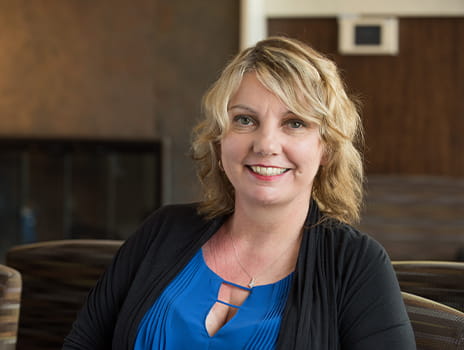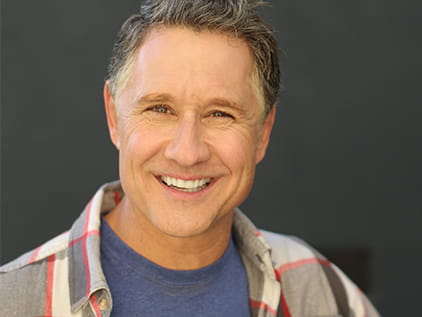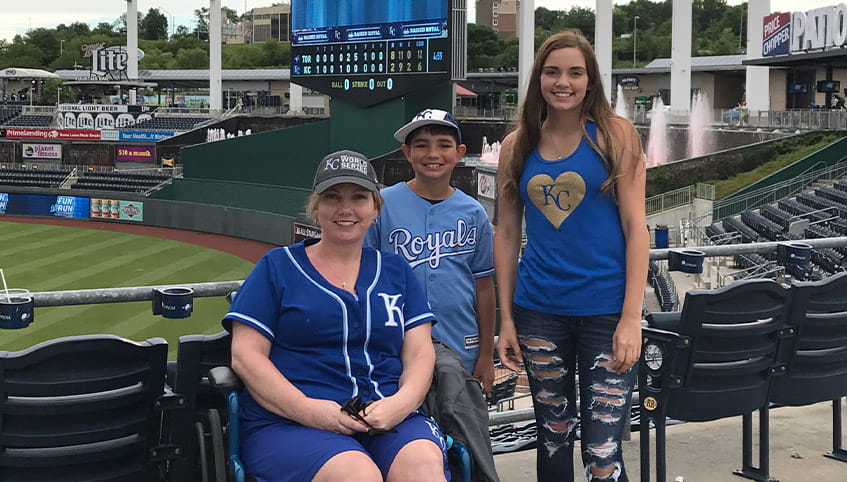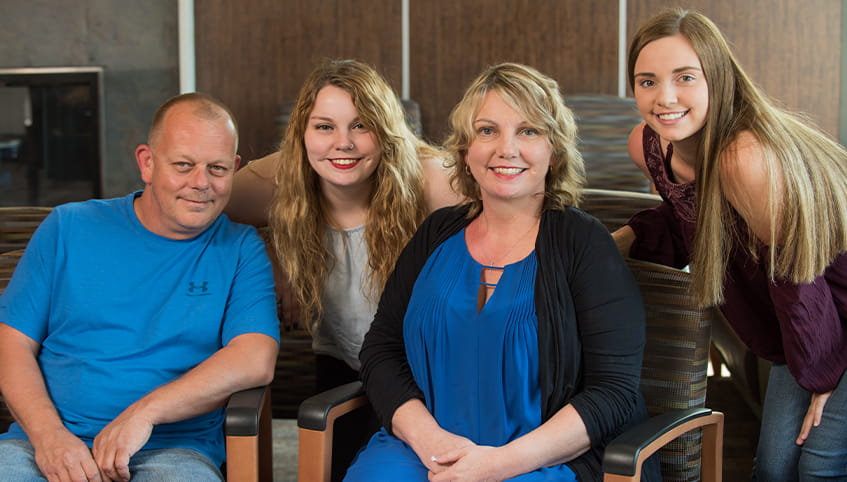Comprehensive Stroke Care and Rehabilitation

In recognition of the Christmas and New Year’s holidays, some of The University of Kansas Health System’s offices will have modified hours on Thursday, December 25, and Thursday, January 1.

On the sunny Sunday afternoon of June 25, 2017, the Kansas City Royals lost to the Toronto Blue Jays. But despite seeing her beloved baseball team defeated, Heather Holiman, 43, was all smiles. It was her first visit to Kauffman Stadium since a hemorrhagic stroke nearly took her life in early April.
Heather had watched the Royals play that April afternoon, too, though on television in her home near St. Joseph, Missouri. After the game, Heather's 19-year-old daughter, Erika, doing homework at the kitchen table, observed concerning behavior in her mother.
"She was at our computer for a minute, and then she threw down her phone," Erika recalls. "I thought that was strange and asked her if she was all right. She said, 'I feel like I'm going to throw up,' and headed toward her room. On her way in, she bumped into the door frame. She wasn't walking right. She said, 'I need medicine,' and then her words became very jumbled."
Recognizing that this was different from the migraine headaches that often plagued Heather, Erika ran for her father, Danny. The 2 decided to take Heather to the local hospital, but couldn't get her up from bed. Erika called a neighbor, an EMT who lived just a few houses away and arrived by ambulance in moments.
Instructed by the EMT to have Heather squeeze both her hands, Erika felt no pressure from her mom's right hand. She feared a stroke.
"It was a classic sign," says Erika.
"My whole side felt heavy," Heather adds. "My mouth and body just went bad on me. In just a few minutes, I was out."
The EMT took Heather by ambulance to the local hospital, where Heather had previously spent 18 years working in health information systems. There, physicians recommended immediate transfer to The University of Kansas Health System's Advanced Comprehensive Stroke Center.

Airlifted to the stroke center, Heather was examined by neurosurgeon Jules Nazzaro, MD, and diagnosed with an acute left basal ganglia intracranial hemorrhagic stroke. A blood vessel had burst in Heather's brain, damaging brain cells as it bled. While hemorrhagic strokes account for only 15% of strokes, they are responsible for about 40% of stroke deaths.1
"The doctor had told us our only chance was to get her to The University of Kansas Health System right away," says Heather's younger daughter, Dallas, 16. "It was a week before we knew whether she would survive."
The stroke care team provided Heather with the most innovative treatment along with access to clinical trials, ensuring the opportunity to benefit from the latest research.
"The stroke Heather experienced was extremely serious and highly life-threatening," Dr. Nazzaro said. "Our position as a premier academic medical center promoting multidisciplinary care was key to her impressive recovery. We were able to consider the very latest in treatment options and ensure that a comprehensive team addressed her immediate and subsequent health challenges."

On April 24, 18 days after the stroke, Heather began the next step on her road to recovery. She was transferred to The University of Kansas Health System's acute inpatient rehabilitation program, where she received the care she needed to recover the abilities the stroke had robbed from her. She saw a physician every day and received speech, physical and occupational therapies.
"From the very first minute, we had an amazing experience here," Danny said. "Heather's cousin, a surgeon in St. Louis, visited us and said we were absolutely in the best place we could be for her care." In addition to the opportunity to work with providers who communicated with Heather's inpatient team and continued seamless care, Danny cited the focus on family as a significant differentiator.
"Other places we considered wouldn't allow family members to stay with Heather," he says. "I was not about to leave her alone. Here, our family was always welcome and involved. Heather's parents and our daughters and I were always with her."
While the togetherness provided support and comfort, it also played a functional role in Heather's recovery.
"It's always important to get buy-in from the family," says Hilary Wingate, Heather's physical therapist. "We do everything we can to build a solid foundation here, but recovery from brain injury is an ongoing process. Patients who achieve the best outcomes are those who have an amazing support system, like Heather does, and who have help to make progress at home."
Wesli Searcy, Heather's occupational therapist, agrees that family support is critical. She also credits the communication among the rehab doctors, nurses, therapists and technicians as a valuable advantage of the program.
"Communication among disciplines is vital," she says. "We talk multiple times throughout the day to compare notes on a patient. We'll ask each other questions like, 'What should we do with the right arm during transfers? How could we do this better?' In all cases, but especially cases like Heather's, where aphasia made it challenging for her to communicate, we want to be very specific and consistent with our approach and instructions. Our working together makes a world of difference for our patients."
"I loved it," Heather says of her neurorehabilitation team and experience. "I had the support and encouragement of doctors, nurses and therapists every day. My care team made me feel that everything was going to be OK. When it was time to go home, I wanted to stay."

Heather might have been apprehensive about her readiness to return home, but Danny wasn't.
"I was very confident in my ability to help Heather at home, and our daughters were, too," he says. "We had so much education and guidance from the rehab team. We learned how to transfer her to her wheelchair, how to walk with her when she used her walker, and how to help her bathe and use the restroom. Her therapists even looked at photos of our home to give us ideas on how we could improve our home environment for her."
There is a dramatic contrast between the first and last days of Heather's 48-day hospitalization.
"When she started our program, Heather had limited speech and movement of the right side," says rehabilitation medicine specialist Sarah Eickmeyer, MD. "When she left the program to return home, she was carrying on meaningful conversations and walking with assistance. Our interdisciplinary approach to her care incorporated therapy, nursing, neuropsychology and physiatry in an individualized plan to restore function and rebuild her life. Heather's persistence, motivation, hard work and amazing family led her to a remarkable recovery."
Heather now uses a cane or walker to move around in her home and a wheelchair for longer distances. She folds the family's laundry and likes to sit outside to play with her golden retriever, Nova.
"It was really hard at first," Dallas says. "We just didn't know where things were going to go. But little by little, her abilities are coming back. I think this has brought our family even closer together. And because of this, I really want to do something in the medical field, maybe become a therapist."
"Everyone – the doctors, the nursing staff, the therapists, the aides – was absolutely great," Danny adds. "I have never had such a good experience in a hospital in my life. We thought we would have the best possible experience at our local hospital, where Heather knew everybody and everybody knew her, but we had as good or better here, where we knew no one. It was the best place she could have been."
We offer a variety of appointment types. Learn more or call 913-588-1227 to schedule now.
Dr. Eickmeyer and her team arranged an ongoing rehabilitation plan and medical follow-up appointments to help Heather continue her recovery. As she no longer requires 24-hour medical or nursing support, Heather receives therapy in Ability KC's day program, but returns to her doctors for clinic visits.
"This is such a big change," Heather says. "Having all my people there to help – people who love doing what they do – that meant so much. And even on the hard days, we could all still laugh at the little things. There were times that we were all having fun."
The Holiman family recently visited the acute inpatient rehabilitation facility. Heather's therapists were thrilled to see how much she had progressed since her discharge.
"The brain continuously changes and reorganizes as it learns," Wingate says. "With the right tools, resources, exercises and support, there is no limit on what patients can achieve after brain injury."
1National Stroke Association, http://www.stroke.org/understand-stroke/what-stroke/hemorrhagic-stroke. Retrieved June 28, 2017.